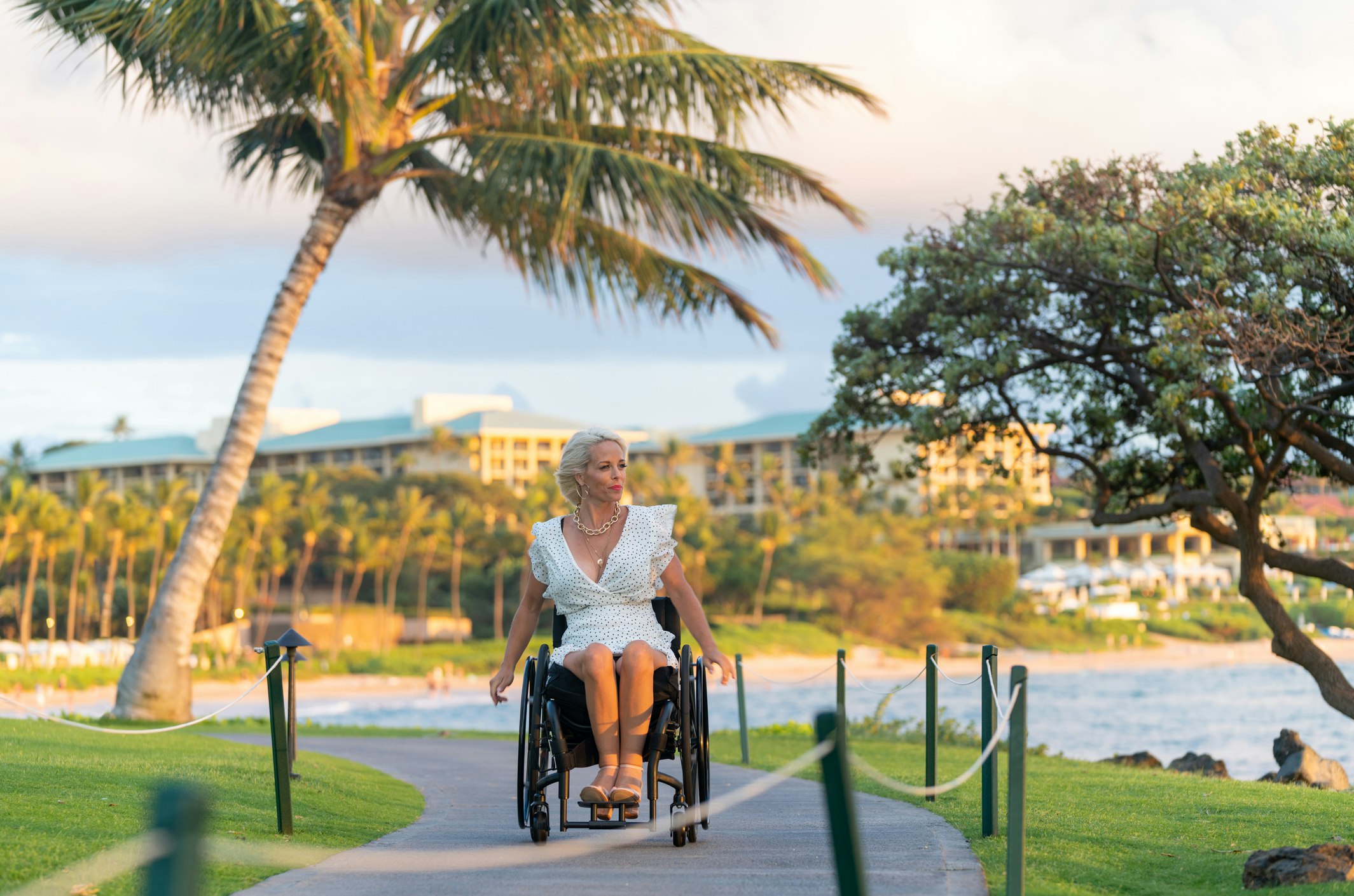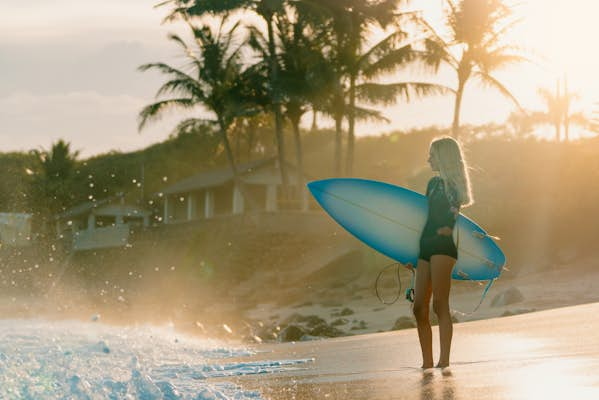Planning a trip to Hawaii, which is top of any tropical vacation bucket list, requires some consideration. The Hawaiian Islands are located in the middle of the Pacific Ocean, literally thousands of miles away from the two nearest landmasses, Alaska and Japan, so having a carefully curated list of activities will help you make the most of your trip on land.
For global wheelchair travelers and those with sensory disabilities, there are additional considerations to ensure a safe and rewarding experience. Use this as your introduction to accessible travel in the Hawaiian Islands, from Oahu to Hawaii Island.
Accessible Travel to Hawaii: What to do before you go
From booking accommodation to being forewarned about traveling with pets, there are a few things you should be well prepared for before you travel.
Airport assistance also available
Hawaii’s most visited islands are Oahu (HNL), Maui (OGG), Kauai (LIH) and Big Island (Kona Airport, KOA, Hilo Airport, ITO). Each airport offers assistance from the terminal to the curbside for travelers with a variety of mobility, vision and hearing needs.
 Accommodation booking sites offer filters for different accessible travel needs, including flat roads © JGalione / Getty Images
Accommodation booking sites offer filters for different accessible travel needs, including flat roads © JGalione / Getty Images
Use filters to book the right accessible accommodation
Major hotel booking sites like Booking.com and alternative lodging sites like Airbnb have search filters to help identify accessibility needs. For example, a search for accessible hotels in Maui on Booking.com returns 18 hotels in Lahaina (Kaanapali Beach Hotel, Sheraton Maui Resort & Spa) and 13 hotels in Wailea (Four Seasons Resort Maui at Wailea, Wailea Beach Villas, etc.).
Airbnb allows you to filter for accessible features like a flat path to the front door, wide doorways and hallways, fixed grab bars in the bathroom, and step-free access to common areas.
Submit the necessary travel documents in advance for your service dog
Air travelers with service or guide dogs must submit all required paperwork to the state’s rabies quarantine station at least 10 days prior to departure. Upon arrival in Hawaii, service or guide dogs must pass inspection and compliance at the airport animal quarantine holding facility or at the airport terminal upon prior request. Please note that Daniel K. Inouye Airport in Honolulu is the port of entry for all dogs and cats coming to the islands.
Notify rental car companies in advance of your accessibility needs
If you give us advance notice, car rental companies at the major island airports will accommodate your accessibility needs and can even deliver your rental car to the airport terminal.
TheBus on Oahu, Kauai Bus on Kauai, Hele-On bus service on the Big Island, and Maui Bus on Maui are all wheelchair accessible and operate paratransit service. Please call us to request paratransit transportation.
Get more travel inspiration, tips and special offers delivered straight to your inbox with our weekly newsletter.
 If requested, the rental company can help deliver the car directly to the airport terminal © darekm101 / Getty Images
If requested, the rental company can help deliver the car directly to the airport terminal © darekm101 / Getty Images
Accessible Experiences: What to do when you get to Hawaii
Hawaii’s main islands offer numerous self-guided and organized recreation and leisure experiences that are available to people with a variety of motor skills and sensory needs.
Many beaches are wheelchair accessible
Many beaches on Oahu, Maui, Kauai and the Big Island feature handicapped parking, all-terrain wheelchair rentals and beach mats for sandy access. The state recognizes handicapped parking permits from other states.
For example, Ala Moana Beach Park, Hanauma Bay Nature Preserve, and Kailua Beach on Oahu offer all-terrain wheelchairs (usually for a two-hour limit) and beach access mats, as do Lydgate Beach Park and Poipu Beach on Kauai. For wheelchair availability or to request a wheelchair, call the City & County of Honolulu Department of Parks and Recreation at (808) 768-3027.
Some beaches on Hawaii Island and Maui are accessible; contact the respective recreation departments for more information.
There are several accessible trails on the islands.
For more information about accessible trails in the Hawaiian Islands, visit the Department of Land and Natural Resources’ Na’alahele Trails and Access Program contact page. The department’s interactive Hawaii Trails Map shows three accessible trails using the “Accessible” filter option in the Activities section of the Advanced Search: Kanealole Trail and Maunalaha Trail in Honolulu, Oahu, and Ohai Loop Trail and Overlook on Maui. More information about Hawaii’s recreational trails is also available in the OuterSpacial app, which includes search filters for wheelchair, hearing-impaired, and visually impaired-friendly outdoor activities.
 Several Hawaii travel companies are adjusting their itineraries to accommodate travelers with different travel requirements © Michael Hanson / Getty Images
Several Hawaii travel companies are adjusting their itineraries to accommodate travelers with different travel requirements © Michael Hanson / Getty Images
Which Hawaiian islands are best for accessible travel?
Whether you’re looking to enjoy laid-back beach days, dynamic cultural experiences or seek out breathtaking natural scenery, here are some of the most accessible activities for each island.
Experience Hawaiian culture in an accessible location on Oahu
Located in the countryside on Oahu’s North Shore, the Polynesian Cultural Center accommodates a variety of mobility, visual and hearing access needs. Activities to explore are plentiful, from visiting island “villages” in Tonga, Fiji, Samoa and more to luau dinner shows. In 2021, the Cultural Center announced Master Chef restaurateur and Hawaii Food & Wine Festival regular Graham Elliott as Executive Chef of Pounders Restaurant, who also influences the menus at the luau and buffet.
Built in 1922, the historic Hawaii Theatre in Honolulu’s Chinatown district is wheelchair accessible and equipped with assistive hearing devices. The theater has hosted numerous live musical, dance and comedy performances, while Blue Note Hawaii is a live performance venue and popular spot for live Hawaiian, jazz and R&B music with wheelchair accessible seating.
Kauai tour operators accommodate travelers with disabilities
Kauai’s undeveloped landscape makes it a popular destination for immersive eco-adventures, even for those with transportation needs. Kipu Ranch Adventures offers private ATV and off-road tours. Their signature three-hour off-road ranch tour takes you through Huleia Valley, past cows, wild pigs, chickens and peacocks. Kauai Backcountry Adventures accommodates those with disabilities or reduced mobility on their tranquil mountain tubing tours through the irrigation system of a former sugar plantation, although some parts of the tour require climbing stairs. They recommend calling ahead if you need to arrange for additional staff to ensure a comfortable experience.
Paved parking lots and viewing areas offer leisurely access to red-soil Waimea Canyon (also known as the Grand Canyon of the Pacific) and Wailua Falls.
Maui offers many wildlife viewing activities, including scuba diving.
Located between the towns of Kihei and Maalaea, the Kealia Pond Coastal Boardwalk is in a national wildlife refuge and features a mile-long (1.6-km) wheelchair-accessible boardwalk along Maalaea Bay. Follow the interpretive signs to spot native (and endangered) birds, such as the Hawaiian stilt with its long pink legs and the Hawaiian coot with its distinctive white beak and black body.
Lahaina Divers offers guiding facilities for anyone to dive from Molokini Crater to Turtle Reef in West Maui. Our staff is Handicapped Scuba Diving Association (HSA) certified.
Maui Ocean Center’s wheelchair accessible Hawaiian Humpback Whales exhibit and 3D theater opened in 2019. Travel along the whales’ migration route from Alaska to Hawaii, create your own whale song, and learn about the role of marine life in Hawaiian culture. Fun fact: The exhibit is shaped and sized to fit a fully grown female humpback whale. Free wheelchairs are available on a first-come, first-served basis. Service dogs are welcome.
 A customised ramp helps wheelchair travellers board a tourist boat © zorazhuang / Getty Images
A customised ramp helps wheelchair travellers board a tourist boat © zorazhuang / Getty Images
There are tours and trails available on the Big Island of Hawaii.
The best place to start your tour of Hawaii’s Volcanoes National Park is the Kilauea Visitor Center, which has wheelchair access and information on the most accessible trails and lookouts, including Haakumamanu (Sulphur Banks) Trail and Kilauea Lookout. American Sign Language interpretation can be arranged by calling (808) 985 6011 at least two weeks prior to your visit. The island is the newest and largest of the main islands due to its volcanic activity.
Body Globe’s 2.5-hour whale watching tours depart from Kona from December through April, and include the chance to see spinner dolphins, manta rays, and sea turtles. Sunset cruises with live music and cocktails are also available. A customized boarding ramp accommodates manual and electric scooters, and the lower deck of the catamaran is fully accessible. Accessible parking is available on a first-come, first-served basis.
Blue Hawaiian operates helicopter tours over the Big Island, Oahu, Maui and Kauai. A custom-built chairlift allows passengers weighing less than 250 pounds to board and disembark from the helicopter.
Other Services and Resources for Travelers with Disabilities
The Hawaii Disability Access and Communications Commission provides more information about accessible travel within the islands. Interpreting Hawaii and Isle Interpret provide sign language interpretation and assistance, including Japanese, Korean, and some European sign languages.
You might also like:
What you need to know before visiting Hawaii
20 Amazing Hawaiian Scenery You’ll Have to See to Believe It: Waterfalls, Volcanoes, and Starry Skies
Top 10 Experiences on Hawaii Island: One of the World’s Most Beautiful Land, Sea, and Air Destinations

